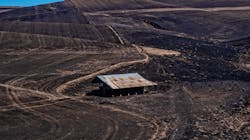The Threat of Fires Widens, as Should Industry’s Response
As I’m writing this, legislators in my home state of Oregon are debating a bill to relieve some of the $3 billion in wildfire related losses the state has seen since 2020. Further to the south, Californians are welcoming millions in federal funding to help communities prevent wildfires and fight them once they break out as part of the Biden administration’s wildfire defense grant program.
Funding from that same $197 million program will be distributed across 22 states and 7 Tribes – some 100 communities in all, according to the Los Angeles Times. This comes on the heels of the $8.25 billion in wildfire management funding made available through the Bipartisan Infrastructure Law and announced this past July.
It’s a cliché now on the West Coast to hear that fire now knows no particular season, and that fire season is in fact year round. However, if the wide swath of the nation that the federal government saw fit to support with new funding is any indication, the danger of out of control fires devastating communities is present from coast to coast.
The U.S. Department of Agriculture keeps a list of wildfire projects under its purview. In Colorado’s Archuleta County, home of segments of the San Juan National Forest, education programs will spread word about fire resistant construction. In the Blackfoot Watershed of Montana, “Fire Refugia” communities will be maintained so fires may pass without destroying homes or infrastructure. In Wyoming’s Crooked Creek area, the landscape will be cleared to reduce fuel loads and restore the health of forests. In North Carolina, funding is granted to develop community protection plans and renew ones that expired.
The federal government’s National Cohesive Wildland Fire Management Strategy has three parts: 1. Maintain resilient landscapes in accordance with land management objectives, 2. Create fire-adapted communities that can better withstand blazes without loss of life or property, and 3. Improve wildfire response across jurisdictions.
Utilities too are responsible for the communities in which they operate. Not just in the sense of facing consequences when things go poorly as has occasionally happened, but in the sense of being a critical part of every community that requires electricity.
As I gathered and reviewed the materials we decided to include in a special annual wildfires supplement to T&D World, I heard from more utilities than in years past, which is a wonderful thing. We always strive to be a utilities-first publication, after all. But it is encouraging to me personally to see utilities taking this growing problem of wildfires as seriously as many are. We need community-minded utility leaders now more than ever, who see themselves as good stewards of their service territories and the people who live and work within them, as well as for the land itself.
Utilities from California, Arizona and Oregon sent us case studies on how they are using advanced sensors, meteorological equipment, remotely piloted drones armed with thermal cameras, integrated vegetation management techniques and other applications, all networked through powerful computers and occasionally applying artificial intelligence to sift through the massive pile of data generated to find signs of wear and tear or other trouble spots that might one day spark a fire. Because in severely dry and hot conditions, it is vastly easier to prevent a blaze than to fight one.
We also heard about the important role of land and water management, which can include things like clearing or thinning our land in strategic areas to minimize the impact of fires on infrastructure, buildings and other property. Utilities, consultants, vegetation management companies and wildfire mitigation firms are even beginning to learn from the traditional practices of Indigenous North Americans who used cultural burning to manage the lands they lived on for thousands of years before colonization by whites. This knowledge is being used by the U.S. Forest Service as well, which has adopted clearing of ladder fuels in heavily wooded areas that are at high fire risk.
Down the road from me at Oregon State University in Corvallis, the College of Forestry teaches these pre-Columbian techniques to students, and OSU’s Extension Fire Program notes that controlled burns achieve a number of healthy forestry goals, including lowering wildfire risks, improving rangelands and encouraging native plant species and providing a healthy wildlife habitats.
With so much of the country under threat by wildfires, it is going to take a full spectrum of disciplines and techniques to combat the problem – some old and some brand new. The raison d'être for these supplements is to show that there are solutions for this problem readily at hand. They were developed by our finest minds and constructed with our most skilled people.
What we need now as an industry is to accept these tactics, techniques and technologies to meet the problem, and not to shy away from change. We have already seen the tragic consequences of putting off needed maintenance and saving money that would have been better spent on public safety measures.
Utilities are entrusted with a great responsibility, and it is up to utilities to show that the public faith in them has been well placed.
About the Author
Jeff Postelwait
Managing Editor
Jeff Postelwait is a writer and editor with a background in newspapers and online editing who has been writing about the electric utility industry since 2008. Jeff is senior editor for T&D World magazine and sits on the advisory board of the T&D World Conference and Exhibition. Utility Products, Power Engineering, Powergrid International and Electric Light & Power are some of the other publications in which Jeff's work has been featured. Jeff received his degree in journalism news editing from Oklahoma State University and currently operates out of Oregon.
